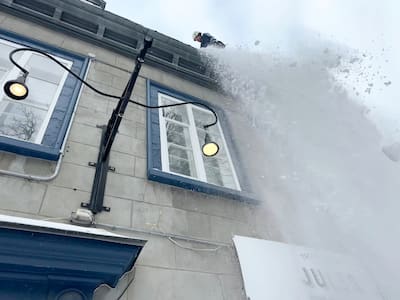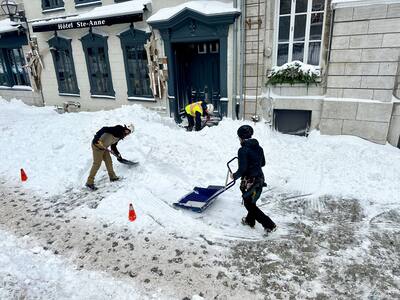In Montreal, journalist Louis-Philippe Messier travels mostly on the run, his desk in his backpack, on the lookout for fascinating subjects and people. He speaks to everyone and is interested in all walks of life in this urban chronicle.
Here’s probably the most athletic and picturesque of the typical winter jobs in our nation’s capital: snow plowing steep roofs.
The Montrealer that I am is fascinated and feels like a tourist in front of this spectacle. Yes, there are old roofs in the metropolis, but it is marginal. Here, there are more than a square kilometer of them.
With their shovels held by a rope to their harness (to prevent them from falling on the head of a possible passerby), the climbing snow clearers of the Snow Squad of the city of Quebec are busy on the tin roof of a building on rue Sainte-Anne, not far from the Dufferin terrace and the Château Frontenac, when I arrived.
The snow squad spent nearly two hours clearing snow from these old roofs on rue Sainte-Anne and creating passages towards the entrances.
Louis-Philippe Messier
Five years ago, on the same street, a 79-year-old pedestrian found herself buried under a small avalanche, courtesy of an uncleared roof. The police pulled her out before she suffocated.
This incident explains the omnipresence of signs “Be careful of falling snow or ice” in Old Quebec or in the Saint-Jean-Baptiste district.
These neighborhoods are among the rare places in the city where prudence dictates walking in the middle of the street rather than on the sidewalks exposed to the calamity that our ancestors, the Gauls, feared: that the Sky would fall on their heads.
Tourists amazed by this “Quebec” spectacle take photos.
Protect passers-by
“Be careful: a baby passes!” exclaims Maxime Gastaud on his radio to his harnessed colleagues scraping the roof.
These stop sending snow down. A father with a carrying infant embarks on the safe path demarcated by small orange cones.
“It’s beautiful, he passed!”

A security perimeter is established during the operation to prevent the shoveled snow from ending up on the head of an innocent tourist.
Louis-Philippe Messier
The work begins again.
“I come from Nice and I worked in the Alps, as a rope access technician, securing the roads by installing nets against falling rocks, but this is my first day as a roof snow remover,” enthuses Mr. Gastaud.
“The view is beautiful.”

Maxime Gastaud, experienced as a rope access technician in the Alps, was on his first day with the Snow Squad.
Louis-Philippe Messier
Among these snow clearers and climbers, there are often pruners. To apply, you must be in good shape, not afraid of heights and obtain certification for working at height after a week of training.
A colleague of Mr. Gastaud has just climbed over the wooden guardrail which prevents the snow from falling suddenly from the roof and, by abseiling down about a meter, he attacks the stalactite icicles, another potential public danger , before going back down completely.
The squad has a large mass to break the ice.
“Ironically, most of our accidents are falls on stairs or on patches of ice when we are clearing snow on the flat and we are less vigilant,” explains Mathieu Barrère, a Frenchman who practices climbing and who clears snow from the peaks of Old Quebec for a seventh season.
“At height, even if we lose our footing, there is the rope to hold us in place.”
“We spend all our time outside and keep fit. For us, winter passes quickly.”
Now that the roof has been cleared of snow, an imposing mound blocks the entrances.
“The last stage of our work is to clear access to residences and businesses,” foreman Mathieu Néron-Turpin told me, out of breath, handling a sled shovel.
Now that the squad has done its work at altitude, a scraper will come and finish the work on the ground.

Clearing the snow at the bottom is not enough: you have to clear the entrances while waiting for the snow to pass.
Louis-Philippe Messier
